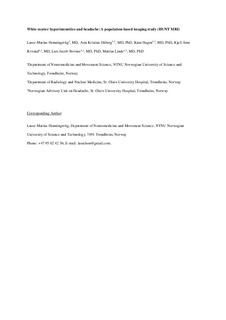| dc.contributor.author | Honningsvåg, Lasse-Marius | |
| dc.contributor.author | Håberg, Asta | |
| dc.contributor.author | Hagen, Knut | |
| dc.contributor.author | Kvistad, Kjell Arne | |
| dc.contributor.author | Stovner, Lars Jacob | |
| dc.contributor.author | Linde, Mattias | |
| dc.date.accessioned | 2019-06-24T11:05:21Z | |
| dc.date.available | 2019-06-24T11:05:21Z | |
| dc.date.created | 2018-03-20T08:17:37Z | |
| dc.date.issued | 2018 | |
| dc.identifier.citation | Cephalalgia. 2018, 38 (13), 1927-1939. | nb_NO |
| dc.identifier.issn | 0333-1024 | |
| dc.identifier.uri | http://hdl.handle.net/11250/2601837 | |
| dc.description.abstract | Objective
To examine the relationship between white matter hyperintensities and headache.
Methods
White matter hyperintensities burden was assessed semi-quantitatively using Fazekas and Scheltens scales, and by manual and automated volumetry of MRI in a sub-study of the general population-based Nord-Trøndelag Health Study (HUNT MRI). Using validated questionnaires, participants were categorized into four cross-sectional headache groups: Headache-free (n = 551), tension-type headache (n = 94), migraine (n = 91), and unclassified headache (n = 126). Prospective questionnaire data was used to further categorize participants into groups according to the evolution of headache during the last 12 years: Stable headache-free, past headache, new onset headache, and persistent headache. White matter hyperintensities burden was compared across headache groups using adjusted multivariate regression models.
Results
Individuals with tension-type headache were more likely to have extensive white matter hyperintensities than headache-free subjects, with this being the case across all methods of white matter hyperintensities assessment (Scheltens scale: Odds ratio, 2.46; 95% CI, 1.44–4.20). Migraine or unclassified headache did not influence the odds of having extensive white matter hyperintensities. Those with new onset headache were more likely to have extensive white matter hyperintensities than those who were stable headache-free (Scheltens scale: Odds ratio, 2.24; 95% CI, 1.13–4.44).
Conclusions
Having tension-type headache or developing headache in middle age was linked to extensive white matter hyperintensities. These results were similar across all methods of assessing white matter hyperintensities. If white matter hyperintensities treatment strategies emerge in the future, this association should be taken into consideration. | nb_NO |
| dc.language.iso | eng | nb_NO |
| dc.publisher | SAGE Publications | nb_NO |
| dc.title | White matter hyperintensities and headache: A population-based imaging study (HUNT MRI) | nb_NO |
| dc.type | Journal article | nb_NO |
| dc.type | Peer reviewed | nb_NO |
| dc.description.version | acceptedVersion | nb_NO |
| dc.source.pagenumber | 1927-1939 | nb_NO |
| dc.source.volume | 38 | nb_NO |
| dc.source.journal | Cephalalgia | nb_NO |
| dc.source.issue | 13 | nb_NO |
| dc.identifier.doi | 10.1177/0333102418764891 | |
| dc.identifier.cristin | 1574187 | |
| dc.description.localcode | © 2018. This is the authors' accepted and refereed manuscript to the article. The final authenticated version is available online at: https://doi.org/10.1177%2F0333102418764891 | nb_NO |
| cristin.unitcode | 194,65,30,0 | |
| cristin.unitname | Institutt for nevromedisin og bevegelsesvitenskap | |
| cristin.ispublished | true | |
| cristin.fulltext | postprint | |
| cristin.qualitycode | 1 | |
